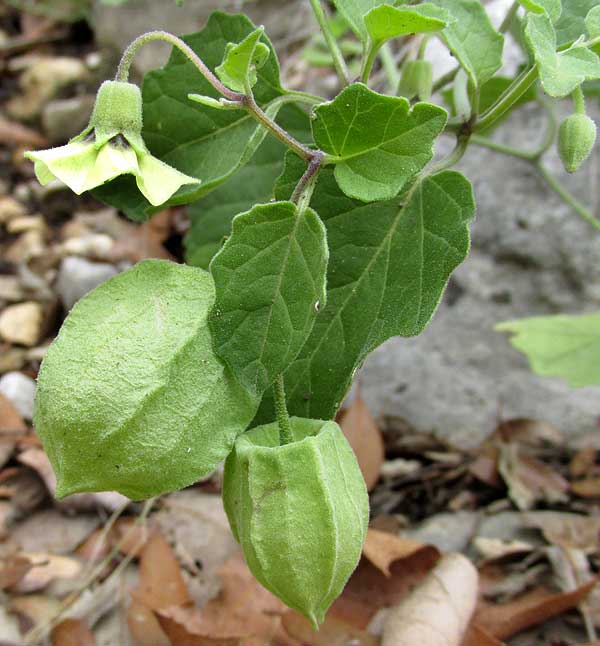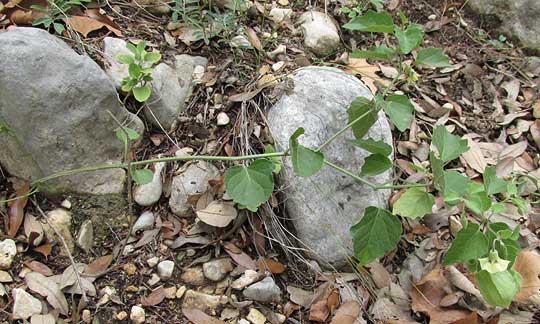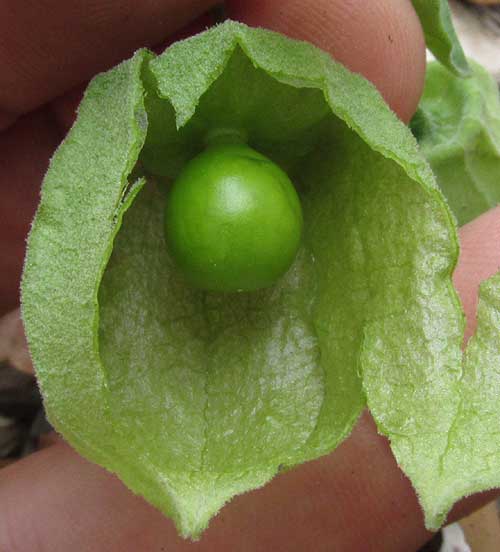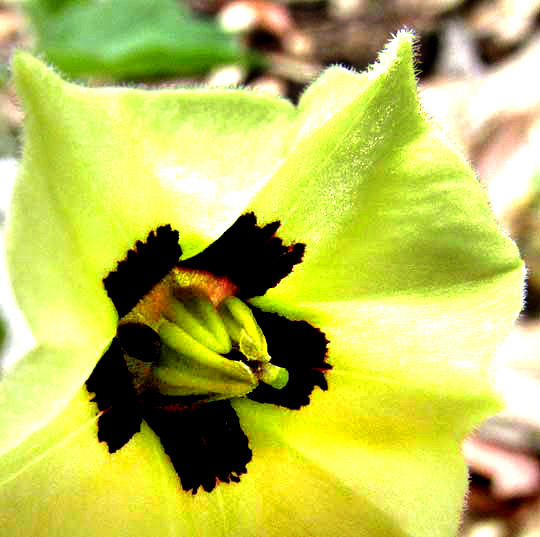Excerpts from Jim Conrad's
Naturalist Newsletter

from the September 21, 2014 Newsletter issued from the Frio Canyon Nature Education Center in the valley of the Dry Frio River in northern Uvalde County, southwestern Texas, on the southern border of the Edwards Plateau; elevation ~1750m (~5750 ft); N29.62°, W99.86°; USA
SMALLFLOWER GROUNDCHERRY
On a dry, rocky slope in limestone country a wildflower caught my eye because I was accustomed to seeing its kind of flowers and fruits on weeds in disturbed places, but this one apparently was a native adapted to our dry, highly calcareous (carbonate-rich) soil. You can see it below, so spindly that it practically lies on the ground:

If you're familiar with our weeds you'll probably recognize that this is a kind of groundcherry because of its unusual and very distinctive flowers and fruits, as seen at the top of this page.
Here are the two main features so characteristic of groundcherries -- genus Physalis of the Nightshade or Potato Family, the Solanaceae:
The fruits' bladdery walls are like paper and can be broken open easily to reveal the developing tomato-like fruit inside it, as shown below:

The pea-shaped item will enlarge and mature into something tasty. If you're familiar with the fruit called tomatillo of husk tomato -- like a small, firm, green tomato encased in a paper bladder and much used in Mexican cuisine -- you'll believe that tomatillos are very closely related to groundcherries. Tomatillos also belong to the genus Physalis.
Our plant's flower colors, though very unusual for the Nightshade or Potato Family, are typical of Physalis, which is greenish yellow with a very dark center, as shown below:

In that picture, note the dense covering of fine, short hairs on the corolla. In fact, the whole plant is "downy" with such hairs, and that's a feature helping us identify our groundcherry to species level. It's the Smallflower Groundcherry, PHYSALIS CINERASCENS, in the US found mostly in Texas, Oklahoma and New Mexico but scattered here and there in surrounding states, and also throughout Mexico. Some experts recognize a species named Physalis mollis, supposed to be hairier than P. cinerascens, but nowadays most regard P. mollis as just a hairy form of P. cinerascens.
Actually, it's curious that groundcherries, genus Physalis, should have flowers and fruits so different from those of other members of the Nightshade or Potato Family, yet within the genus, typically flowers and fruits are remarkably similar from one species to another. Apparently, a ancient ancestor stumbled upon the unusual combination of features, and found it so effective that the ancestor engendered a host of "variations on the groundcherry themes," or "species of the genus Physalis."
Something else that's funny about groundcherry species is that normally they produce extensive underground rhizomes, so if you find a small group of them, they may all be shoots of the same plant. Yet, groundcherry flowers are strongly "xenogamous," which means that pollinators must transfer pollen grains from the stamen of one plant to the stigma of a different plant (not just a different shoot of the same plant) for seed-bearing fruit to be produced. Thus sometimes you find colonies of groundcherry plants which really are all the same plant, with none or few of the shoots producing fruits. That's because pollinators may go from shoot to shoot within the small group, not succeeding in transferring pollen between truly different plants. It seems strange that groundcherries would combine extensive rhizome production with "xenogamy."
Groundcherries are mostly pollinated by the insects known as solitary bees, and solitary bee species generally pollinate only one or a few closely related species, so that partly explains how rhizome-producing groundcherries could get away with xenogamy: Certain solitary bee species make a special effort to patronize just them.
This syndrome of fruits suspended in bladders, down-facing flowers with blackish centers, xenogamy, prolific rhizome formation and a heavy dependence on solitary bees for pollination is a complex, not fully understood, but complex and fascinating situation. What a pleasure it'd be to try to figure it all out. If you think you might like to try, a good place to begin is with Janet Sullivan's 1984 paper "Pollination Biology of Physalis viscosa var. cinerascens (Solanaceae)" appearing in the American Journal of Botany, Vol. 71, No 6.